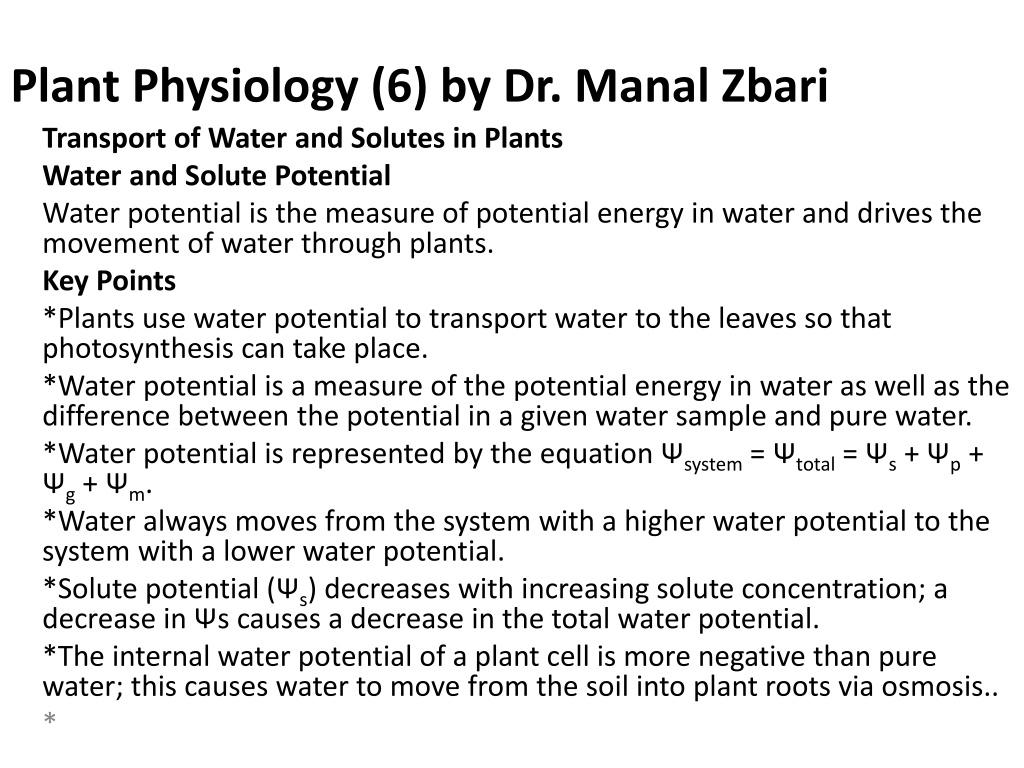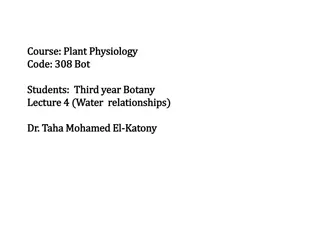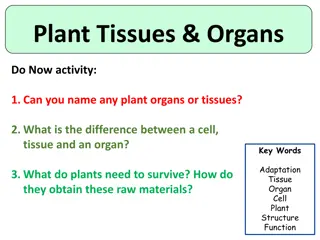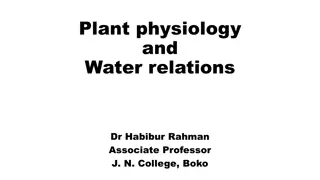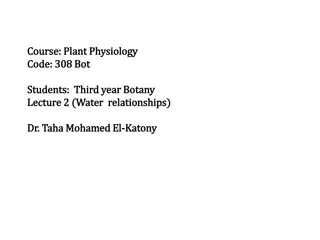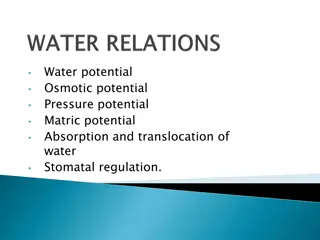Understanding Water Potential in Plant Physiology
Water potential is a crucial concept in plant physiology, driving the movement of water within plants. It is a measure of potential energy in water and influences processes like photosynthesis. This potential is influenced by factors such as solute concentration, pressure, gravity, and matrix effects. Through osmosis, water moves from regions of higher to lower water potential, facilitating the transport of water from soil to plant cells. The intricate balance of water potential components allows plants to efficiently transport water, essential for their growth and survival.
Download Presentation

Please find below an Image/Link to download the presentation.
The content on the website is provided AS IS for your information and personal use only. It may not be sold, licensed, or shared on other websites without obtaining consent from the author. Download presentation by click this link. If you encounter any issues during the download, it is possible that the publisher has removed the file from their server.
E N D
Presentation Transcript
Plant Physiology (6) by Dr. Manal Zbari Transport of Water and Solutes in Plants Water and Solute Potential Water potential is the measure of potential energy in water and drives the movement of water through plants. Key Points *Plants use water potential to transport water to the leaves so that photosynthesis can take place. *Water potential is a measure of the potential energy in water as well as the difference between the potential in a given water sample and pure water. *Water potential is represented by the equation system= total= s+ p+ g+ m. *Water always moves from the system with a higher water potential to the system with a lower water potential. *Solute potential ( s) decreases with increasing solute concentration; a decrease in s causes a decrease in the total water potential. *The internal water potential of a plant cell is more negative than pure water; this causes water to move from the soil into plant roots via osmosis.. *
Key Terms solute potential: (osmotic potential) pressure which needs to be applied to a solution to prevent the inward flow of water across a semipermeable membrane transpiration: the loss of water by evaporation in terrestrial plants, especially through the stomata; accompanied by a corresponding uptake from the roots water potential: the potential energy of water per unit volume; designated by . in the Water Potential plants are phenomenal hydraulic engineers. Using only the basic laws of physics and the simple manipulation of potential energy, plants can move water to the top of a 116-meter-tall tree. Plants can also use hydraulics to generate enough force to split rocks and buckle sidewalks. Water potential is critical for moving water to leaves so that photosynthesis can take place.
Water potential in plants: With heights nearing 116 meters, (a) coastal redwoods (Sequoia sempervirens) are the tallest trees in the world. Plant roots can easily generate enough force to (b) buckle and break concrete sidewalks
Water potential is a measure of the potential energy in water, or the difference in potential energy between a given water sample and pure water (at atmospheric pressure and ambient temperature). Water potential is denoted by the Greek letter (psi) and is expressed in units of pressure (pressure is a form of energy) called megapascals (MPa). The potential of pure water ( wpure H2O) is designated a value of zero (even though pure water contains plenty of potential energy, that energy is ignored). Water potential values for the water in a plant root, stem, or leaf are, therefore, expressed in relation to wpure H2O. The water potential in plant solutions is influenced by solute concentration, pressure, gravity, and factors called matrix effects. Water potential can be broken down into its individual components using the following equation: system= total= s+ p+ g+ m where s= solute potential p, = pressure potential g, = gravity potential m= matric potential
Definition of Water Potential Water potential is the potential energy of water in a system compared to pure water, when both temperature and pressure are kept the same. It can also be described as a measure of how freely water molecules can move in a particular environment or system. It is measured in kilopascals (kPa) and is represented by the Greek letter Psi ( ). Water potential is never positive but has a maximum value of zero, which is that of pure water at atmospheric pressure. When it comes to impure water, or water that has solutes in it, the more solute there is, the more negative becomes, since the solute molecules will attract the water molecules and restrict their freedom to move.
System can refer to the water potential of the soil water ( soil), root water ( root), stem water ( stem), leaf water ( leaf), or the water in the atmosphere ( atmosphere), whichever aqueous system is under consideration. As the individual components change, they raise or lower the total water potential of a system. When this happens, water moves to equilibrate, moving from the system or compartment with a higher water potential to the system or compartment with a lower water potential. This brings the difference in water potential between the two systems ( ) back to zero ( = 0). Therefore, for water to move through the plant from the soil to the air (a process called transpiration), the conditions must exist as such: soil> root> stem> leaf> atmosphere. Water only moves in response to , not in response to the individual components. However, because the individual components influence the total system, a plant can control water movement by manipulating the individual components (especially s).
Solute Potential Solute potential ( s), also called osmotic potential, is negative in a plant cell and zero in distilled water. Typical values for cell cytoplasm are 0.5 to 1.0 MPa. Solutes reduce water potential (resulting in a negative w) by consuming some of the potential energy available in the water. Solute molecules can dissolve in water because water molecules can bind to them via hydrogen bonds; a hydrophobic molecule like oil, which cannot bind to water, cannot go into solution. The energy in the hydrogen bonds between solute molecules and water is no longer available to do work in the system because it is tied up in the bond. In other words, the amount of available potential energy is reduced when solutes are added to an aqueous system. Thus, sdecreases with increasing solute concentration. Because sis one of the four components of systemor total, a decrease in swill cause a decrease in total. The internal water potential of a plant cell is more negative than pure water because of the cytoplasm s high solute content. Because of this difference in water potential, water will move from the soil into a plant s root cells via the process of osmosis. This is why solute potential is sometimes called osmotic potential.
Solute potential: In this example with a semipermeable membrane between two aqueous systems, water will move from a region of higher to lower water potential until equilibrium is reached. Solutes ( s), pressure ( p), and gravity ( g) influence total water potential for each side of the tube ( total right or left) and, therefore, the difference between totalon each side ( ). ( m, the potential due to interaction of water with solid substrates, is ignored in this example because glass is not especially hydrophilic). Water moves in response to the difference in water potential between two systems (the left and right sides of the tube). Plant cells can metabolically manipulate s(and by extension, total) by adding or removing solute molecules. Therefore, plants have control over totalvia their ability to exert metabolic control over s. Pressure, Gravity, and Matric Potential Water potential is affected by factors such as pressure, gravity, and matric potentials. Differentiate among pressure, gravity, and matric potentials in plants
Key Points The higher the pressure potential ( p), the more potential energy in a system: a positive pincreases total, while a negative pdecreases total. Positive pressure inside cells is contained by the cell wall, producing turgor pressure, which is responsible for maintaining the structure of leaves; absence of turgor pressure causes wilting. Plants lose water (and turgor pressure) via transpiration through the stomata in the leaves and replenish it via positive pressure in the roots. Pressure potential is controlled by solute potential (when solute potential decreases, pressure potential increases) and the opening and closing of stomata. Gravity potential ( g) removes potential energy from the system because gravity pulls water downwards to the soil, reducing total. Matric potential ( m) removes energy from the system because water molecules bind to the cellulose matrix of the plant s cell walls.
Key Terms turgor pressure: pushes the plasma membrane against the cell wall of plant; caused by the osmotic flow of water from outside of the cell into the cell s vacuole Pressure Potential Pressure potential is also called turgor potential or turgor pressure and is represented by p. Pressure potential may be positive or negative; the higher the pressure, the greater potential energy in a system, and vice versa. Therefore, a positive p(compression) increases total, while a negative p(tension) decreases total. Positive pressure inside cells is contained by the cell wall, producing turgor pressure in a plant. Turgor pressure ensures that a plant can maintain its shape. A plant s leaves wilt when the turgor pressure decreases and revive when the plant has been watered. Pressure potentials are typically around 0.6 0.8 MPa, but can reach as high as 1.5 MPa in a well-watered plant. As a comparison, most automobile tires are kept at a pressure of 30 34 psi or about 0.207-0.234 MPa. Water is lost from the leaves via transpiration (approaching p= 0 MPa at the wilting point) and restored by uptake via the roots.
Turgor pressure: When (a) total water potential (total) is lower outside the cells than inside, water moves out of the cells and the plant wilts. When (b) the total water potential is higher outside the plant cells than inside, water moves into the cells, resulting in turgor pressure ( p), keeping the plant erect.
A plant can manipulate pvia its ability to manipulate s(solute potential) and by the process of osmosis. Plants must overcome the negative forces of gravity potential ( g) and matric potential ( m) to maintain a positive pressure potential. If a plant cell increases the cytoplasmic solute concentration: swill decline totalwill decline the between the cell and the surrounding tissue will decline water will move into the cell by osmosis pwill increase. Plants can also regulate pby opening and closing the stomata. Stomatal openings allow water to evaporate from the leaf, reducing pand total. This increases water potential between the water in the the petiole (base of the leaf) and in the leaf, thereby encouraging water to flow from the petiole into the leaf. Gravity Potential Gravity potential ( g) is always negative or zero in a plant with no height. Without height, there is no potential energy in the system. The force of gravity pulls water downwards to the soil, which reduces the total amount of potential energy in the water in the plant ( total). The taller the plant, the taller the water column, and the more influential gbecomes. On a cellular scale and in short plants, this effect is negligible and easily ignored. However, over the height of a tall tree like a giant coastal redwood, the plant must overcome an extra 1MPa of resistance because of the gravitational pull of 0.1 MPa m-1.
Matric Potential Matric potential ( m) is the amount of water bound to the matrix of a plant via hydrogen bonds and is always negative to zero. In a dry system, it can be as low as 2 MPa in a dry seed or as high as zero in a water-saturated system. Every plant cell has a cellulosic cell wall, which is hydrophilic and provides a matrix for water adhesion, hence the name matric potential. The binding of water to a matrix always removes or consumes potential energy from the system. mis similar to solute potential because the hydrogen bonds remove energy from the total system. However, in solute potential, the other components are soluble, hydrophilic solute molecules, whereas in m, the other components are insoluble, hydrophilic molecules of the plant cell wall.mcannot be manipulated by the plant and is typically ignored in well-watered roots, stems, and leaves. Movement of Water and Minerals in the Xylem Transpiration aids in the movement of water and minerals in the xylem, but it must be controlled in order to prevent water loss. Key Points The cohesion tension theory of sap ascent explains how how water is pulled up from the roots to the top of the plant. Evaporation from mesophyll cells in the leaves produces a negative water potential gradient that causes water and minerals to move upwards from the roots through the xylem. Gas bubbles in the xylem can interrupt the flow of water in the plant, so they must be reduced through small perforations between vessel elements. Transpiration is controlled by the opening and closing of stomata in response to environmental cues. Stomata must open for photosynthesis and respiration, but when stomata are open, water vapor is lost to the external environment, increasing the rate of transpiration. Desert plants and plants with limited water access prevent transpiration and excess water loss by utilizing a thicker cuticle, trichomes, or multiple epidermal layers.
Key Terms cohesion tension theory of sap ascent: explains the process of water flow upwards (against the force of gravity) through the xylem of plants cavitation: the formation, in a fluid, of vapor bubbles that can interrupt water flow through the plant trichome: a hair- or scale-like extension of the epidermis of a plant Movement of Water and Minerals in the Xylem Most plants obtain the water and minerals they need through their roots. The path taken is: soil -> roots -> stems -> leaves. The minerals (e.g., K+, Ca2+) travel dissolved in the water (often accompanied by various organic molecules supplied by root cells). Water and minerals enter the root by separate paths which eventually converge in the stele, or central vascular bundle in roots. Transpiration is the loss of water from the plant through evaporation at the leaf surface. It is the main driver of water movement in the xylem. Transpiration is caused by the evaporation of water at the leaf, or atmosphere interface; it creates negative pressure (tension) equivalent to 2 MPa at the leaf surface. However, this value varies greatly depending on the vapor pressure deficit, which can be insignificant at high relative humidity (RH) and substantial at low RH. Water from the roots is pulled up by this tension. At night, when stomata close and transpiration stops, the water is held in the stem and leaf by the cohesion of water molecules to each other as well as the adhesion of water to the cell walls of the xylem vessels and tracheids. This is called the cohesion tension theory of sap ascent.
The cohesion-tension theory explains how water moves up through the xylem. Inside the leaf at the cellular level, water on the surface of mesophyll cells saturates the cellulose microfibrils of the primary cell wall. The leaf contains many large intercellular air spaces for the exchange of oxygen for carbon dioxide, which is required for photosynthesis. The wet cell wall is exposed to the internal air space and the water on the surface of the cells evaporates into the air spaces. This decreases the thin film on the surface of the mesophyll cells. The decrease creates a greater tension on the water in the mesophyll cells, thereby increasing the pull on the water in the xylem vessels. The xylem vessels and tracheids are structurally adapted to cope with large changes in pressure. Small perforations between vessel elements reduce the number and size of gas bubbles that form via a process called cavitation. The formation of gas bubbles in the xylem is detrimental since it interrupts the continuous stream of water from the base to the top of the plant, causing a break (embolism) in the flow of xylem sap. The taller the tree, the greater the tension forces needed to pull water in a continuous column, increasing the number of cavitation events. In larger trees, the resulting embolisms can plug xylem vessels, making them non-functional.
CohesionTension Theory of Sap Ascent: The cohesiontension theory of sap ascent is shown. Evaporation from the mesophyll cells produces a negative water potential gradient that causes water to move upwards from the roots through the xylem.
Control of Transpiration Transpiration is a passive process: metabolic energy in the form of ATP is not required for water movement. The energy driving transpiration is the difference in energy between the water in the soil and the water in the atmosphere. However, transpiration is tightly controlled. The atmosphere to which the leaf is exposed drives transpiration, but it also causes massive water loss from the plant. Up to 90 percent of the water taken up by roots may be lost through transpiration. Leaves are covered by a waxy cuticle on the outer surface that prevents the loss of water. Regulation of transpiration, therefore, is achieved primarily through the opening and closing of stomata on the leaf surface. Stomata are surrounded by two specialized cells called guard cells, which open and close in response to environmental cues such as light intensity and quality, leaf water status, and carbon dioxide concentrations. Stomata must open to allow air containing carbon dioxide and oxygen to diffuse into the leaf for photosynthesis and respiration. When stomata are open, however, water vapor is lost to the external environment, increasing the rate of transpiration. Therefore, plants must maintain a balance between efficient photosynthesis and water loss. Plants have evolved over time to adapt to their local environment and reduce transpiration. Desert plant (xerophytes) and plants that grow on other plants ( epiphytes ) have limited access to water. Such plants usually have a much thicker waxy cuticle than those growing in more moderate, well-watered environments (mesophytes). Aquatic plants (hydrophytes) also have their own set of anatomical and morphological leaf adaptations.
Reducing Transpiration: Plants are suited to their local environment. (a) Xerophytes, like this prickly pear cactus (Opuntia sp.) and (b) epiphytes such as this tropical Aeschynanthus perrottetiihave adapted to very limited water resources. The leaves of a prickly pear are modified into spines, which lowers the surface-to-volume ratio and reduces water loss. Photosynthesis takes place in the stem, which also stores water. (b) A. perrottetii leaves have a waxy cuticle that prevents water loss. (c) Goldenrod (Solidago sp.) is a mesophyte, well suited for moderate environments. (d) Hydrophytes, like this fragrant water lily (Nymphaea odorata), are adapted to thrive in aquatic environments. Xerophytes and epiphytes often have a thick covering of trichomes or stomata that are sunken below the leaf s surface. Trichomes are specialized hair-like epidermal cells that secrete oils and other substances. These adaptations impede air flow across the stomatal pore and reduce transpiration. Multiple epidermal layers are also commonly found in these types of plants. Transportation of Photosynthates in the Phloem Translocation moves photosynthates via the phloem from sources to sinks.
Key Points The products of photosynthesis are called photosynthates; they are usually in the form of simple sugars, such as sucrose. Photosynthates are produced by sources and are translocated to sinks. Photosynthates are directed primarily to the roots during early development, to shoots and leaves during vegetative growth, and to seeds and fruits during reproductive development. Photosynthates are produced in the mesophyll cells of leaves and are translocated through the phloem; they are then transported to STEs and translocated to the nearest sink. The high percentage of sugar in phloem sap causes water to move from the xylem into the phloem, which increases water pressure inside the phloem, causing the sap to move from source to sink. Sucrose concentration in the sink cells is lower than in the phloem STEs, so unloading at the sink end of the phloem tube occurs by either diffusion or active transport of sucrose molecules from an area of high concentration to one of low concentration. Key Terms source: structure that produces photosynthates photosynthate: any compound that is a product of photosynthesis sieve-tube element: a type of plant cell located in the phloem that is involved in the movement of carbohydrates sink: where sugars are delivered in a plant, such as the roots, young shoots, and developing seeds
Transportation of Photosynthates in the Phloem Plants need an energy source to grow. In seeds and bulbs, food is stored in polymers (such as starch) that are converted by metabolic processes into sucrose for newly- developing plants. Once green shoots and leaves begin to grow, plants can produce their own food by photosynthesis. The products of photosynthesis are called photosynthates, which are usually in the form of simple sugars such as sucrose. Sources and Sinks Sources are the structures that produce photosynthates for the growing plant. The sugars produced in the sources, such as leaves, must be delivered to growing parts of the plant. These sugars are transported through the plant via the phloem in a process called translocation. The points of sugar delivery, such as roots, young shoots, and developing seeds, are called sinks. Seeds, tubers, and bulbs can be either a source or a sink, depending on the plant s stage of development and the season.The products from the source are usually translocated to the nearest sink through the phloem. For example, photosynthates produced in the upper leaves will travel upward to the growing shoot tip, while photosynthates in the lower leaves will travel downward to the roots. Intermediate leaves will send products in both directions. The multidirectional flow of phloem contrasts the flow of xylem, which is always unidirectional (soil to leaf to atmosphere). However, the pattern of photosynthate flow changes as the plant grows and develops. Photosynthates are directed primarily to the roots during early development, to shoots and leaves during vegetative growth, and to seeds and fruits during reproductive development. They are also directed to tubers for storage.
Translocation: Transport from Source to Sink Photosynthates are produced in the mesophyll cells of photosynthesizing leaves. From there, they are translocated through the phloem where they are used or stored. Mesophyll cells are connected by cytoplasmic channels called plasmodesmata. Photosynthates move through plasmodesmata to reach phloem sieve-tube elements (STEs) in the vascular bundles. From the mesophyll cells, the photosynthates are loaded into the phloem STEs. The sucrose is actively transported against its concentration gradient (a process requiring ATP) into the phloem cells using the electrochemical potential of the proton gradient. This is coupled to the uptake of sucrose with a carrier protein called the sucrose-H+symporter. Phloem STEs have reduced cytoplasmic contents and are connected by sieve plates with pores that allow for pressure-driven bulk flow, or translocation, of phloem sap. Companion cells are associated with STEs. They assist with metabolic activities and produce energy for the STEs.
Translocation to the phloem: Phloem is comprised of cells called sieve-tube elements. Phloem sap travels through perforations called sieve tube plates. Neighboring companion cells carry out metabolic functions for the sieve-tube elements and provide them with energy. Lateral sieve areas connect the sieve-tube elements to the companion cells. Once in the phloem, the photosynthates are translocated to the closest sink. Phloem sap is an aqueous solution that contains up to 30 percent sugar, minerals, amino acids, and plant growth regulators. The high percentage of sugar decreases s,which decreases the total water potential, causing water to move by osmosis from the adjacent xylem into the phloem tubes. This flow of water increases water pressure inside the phloem, causing the bulk flow of phloem sap from source to sink. Sucrose concentration in the sink cells is lower than in the phloem STEs because the sink sucrose has been metabolized for growth or converted to starch (for storage) or other polymers (for structural integrity). Unloading at the sink end of the phloem tube occurs by either diffusion or active transport of sucrose molecules from an area of high concentration to one of low concentration. Water diffuses from the phloem by osmosis and is then transpired or recycled via the xylem back into the phloem sap.
Translocation to the sink: Sucrose is actively transported from source cells into companion cells and then into the sieve-tube elements. This reduces the water potential, which causes water to enter the phloem from the xylem. The resulting positive pressure forces the sucrose- water mixture down toward the roots, where sucrose is unloaded. Transpiration causes water to return to the leaves through the xylem vessels. http://1.bp.blogspot.com/-k3GhSC9sb-I/VUfU-GhwLCI/AAAAAAAACDg/G9AuYTiOdlo/s320/03A.%2B%2BWater%2Bpotential.jpg http://3.bp.blogspot.com/-tCAwij5f37M/VUJrGUCU39I/AAAAAAAACDI/ZtyWj4O3Kg4/s1600/Apoplast%2B-%2Bsymplast.jpg
Quiz:- 1. What can we expect to observe if we place a cell inside a solution where the cell s is equal to -0.3 kPa and that of the solution is -0.9 kPa? A. Water will move out of the cell B. Water will move into the cell C. Water will not move into or out of the cell D. The cell will burst 2. Simply put, water potential is: A. The amount of water that roots can take up per day B. The combination of osmotic pressure and gravitational forces C. The combination of solute potential and pressure potential D. The amount of pressure needed to push water up a plant stem 3. Which of the following values of water potential indicates the driest environment? A. -0.1 pKa B. -1 pKa C. -0.03 pKa D. -5 pKa 4. How does water potential vary in relation to solute concentration? A. It increases the higher the solute concentration B. It decreases the higher the solute concentration C. It is not affected by the concentration of solute D. Solute concentration has an inconsistent effect on it
